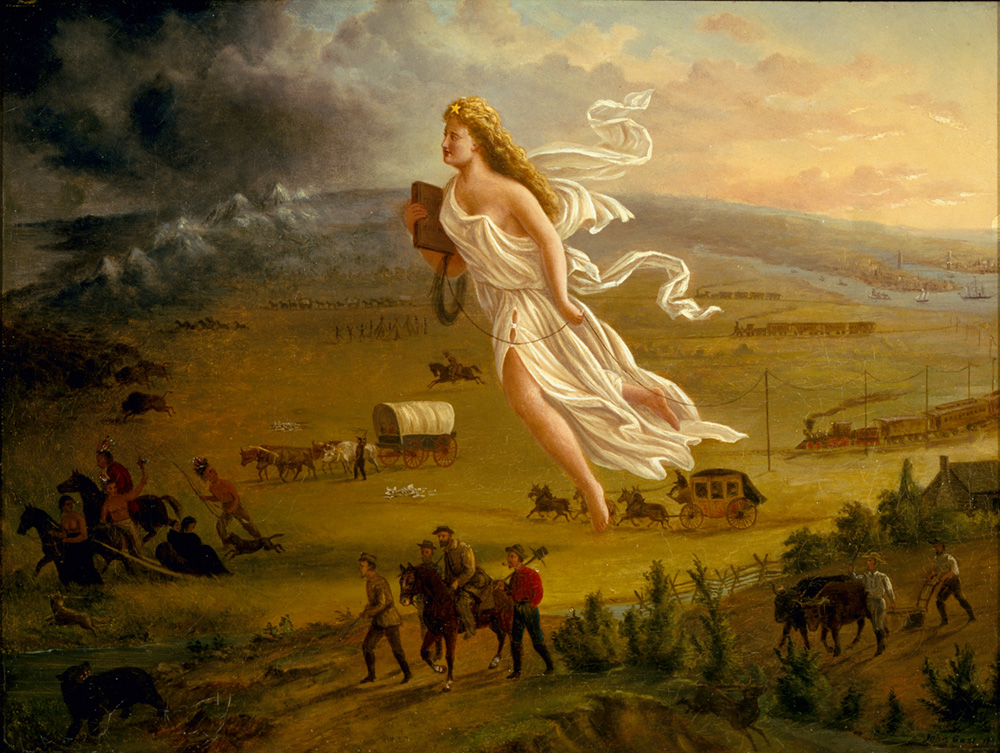The Headlines
PROGRESS REPORT. Since Donald Trump took office for his second term, the Department of Homeland Security has used its social media to post artworks that ostensibly speak to American greatness, rankling some, including the Thomas Kinkade Foundation, which said it was considering legal action over the unauthorized usage of the artist’s work. But what did DHS really mean when it posted an image of American Progress, an 1872 painting by John Gast, a German immigrant who allegorized Manifest Destiny by showing Native Americans being forced out of his picture? The New York Times explored the matter and approached Stephen Aron, the director of the Autry Museum of the American West in Los Angeles, which owns the work. “I don’t know of any current American history textbook that would present American Progress as an accurate account of westward expansion,” Aron said, describing the work as “one of the ways 19th-century white Americans wished to imagine it.”
Related Articles

AN “ANTI-ART” ART COURSE is roiling the student community of the University of New South Wales in Australia, where a class called “Generative AI for Artists” is among the offerings this year. That course is taught by Oliver Brown, who said he has faced a “layer cake of nightmares” after the course was listed. Robyn, a fine arts student at the school, launched a petition demanding that the course be canceled; it currently has more than 7,000 signatures, according to the Guardian. For now, at least, the school has continued to defend the course. A school spokesperson told the Guardian that Brown would offer a “thoughtful integration” of his subject and that he would “ensure students are well-equipped to navigate an increasingly AI-integrated world.”
The Digest
Arts organizations and galleries throughout New South Wales, Australia, breathed a sigh of relief after the state government announced $15.4 million in funding over two years, easing concerns about a potential crisis facing regional galleries in the region. [The Guardian]
Fresh from promoting the Frick Collection online, the actor and comedian Steve Martin is now backing a new movie tracing the origins of the Western Desert art movement. He has skin in the game: Martin owns more than 100 Aboriginal artworks. [Australian Financial Review]
Indigenous art is having a moment. Frieze writes that shows at Tate Modern and Fondation Opale, and Frieze Week presentations of Tony Albert, Robyn Kahukiwa,and George Tjungurrayi signal a decisive shift in the UK. [Frieze]
A couple months ago, the New York Times shook up its culture desk by reassigning four critics to new roles, sparking uproar. People asked if art criticism was under fire. Now it’s the Guardian’s turn. The paper recently ran a article titled: “The death of the review? Cultural criticism is at risk of erasure.” [The Guardian]
The Kicker
DUST TO DUST. A hurricane-force dust storm destroyed an art installation at the Burning Man festival in Nevada. Oleskiy Sai’s work Black Cloud (2025) was a 100-foot-tall inflatable that loomed high above viewers’ heads—until heavy winds snapped it in two. But not all is lost: the artist plans to rebuild the piece. The work’s producer, Vitaliy Deynega, expressed hope, telling the Art Newspaper, “Everyone already knows that we have a war, but I want the world to see Ukraine as a country that can make beauty and can make art and that’s why we’re surviving.”

